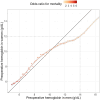Preoperative hemoglobin thresholds for survival equity in women and men
- PMID: 38545508
- PMCID: PMC10965651
- DOI: 10.3389/fmed.2024.1334773
Preoperative hemoglobin thresholds for survival equity in women and men
Abstract
Anemia affects humans throughout life, and is linked to higher morbidity and mortality. Unclear is whether hemoglobin values are equivalent between women and men. This study evaluates the association of preoperative hemoglobin levels with in-hospital mortality and estimates thresholds for survival equity between men and women. All adult patients undergoing surgery between 2010 and 2019 from 14 German hospitals were included in the study. Thresholds for survival equity were determined with generalized additive models. In total, 842,130 patients with a median in-hospital follow-up time of 7 days were analyzed. During follow-up 20,370 deaths occurred. Preoperative hemoglobin stratified in-hospital mortality (log-rank test p < 0.001) and was associated with mortality independently of demographic risk, surgical risk and health status. For each 1 g/dL reduction in preoperative hemoglobin, the odds of mortality increased by a factor of 1.22 (95% CI 1.21-1.23, p < 0.001). A preoperative hemoglobin threshold of 10.5 g/dL reflected equivalent risk for both male and female patients. Hemoglobin levels below 10.5 g/dL had higher risk of mortality for women than for men. The findings from this study aid evidence-based thresholds, inform anemia management and promote equitable care, thus enhancing patient outcomes.
Keywords: anemia; equitable health care; hemoglobin; perioperative management; perioperative medicine.
Copyright © 2024 Rumpf, Hof, Old, Friederich, Friedrich, Thoma, Wittmann, Zacharowski, Choorapoikayil, Meybohm and German Patient Blood Management Network Collaborators.
Conflict of interest statement
KZ’s department received grants from B. Braun Melsungen, CSL Behring, Fresenius Kabi, and Vifor Pharma for the implementation of the German PBM programme. PM and KZ received honoraria for scientific lectures from B. Braun Melsungen, Vifor Pharma, Ferring, CSL Behring, and Pharmacosmos. JT received horonaria for scientific lectures from Vifor Pharma Germany. PF received honoraria for scientific lectures from Medtronic, and honoraria for scientific lectures and consultancy from Dräger. The remaining authors declare that the research was conducted in the absence of any commercial or financial relationships that could be construed as a potential conflict of interest.
Figures




References
LinkOut - more resources
Full Text Sources

